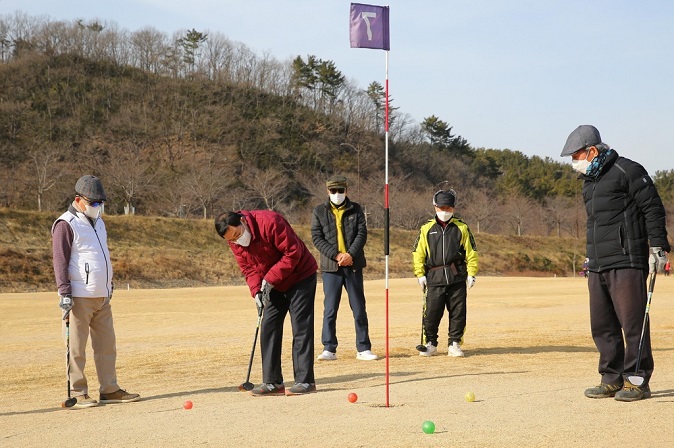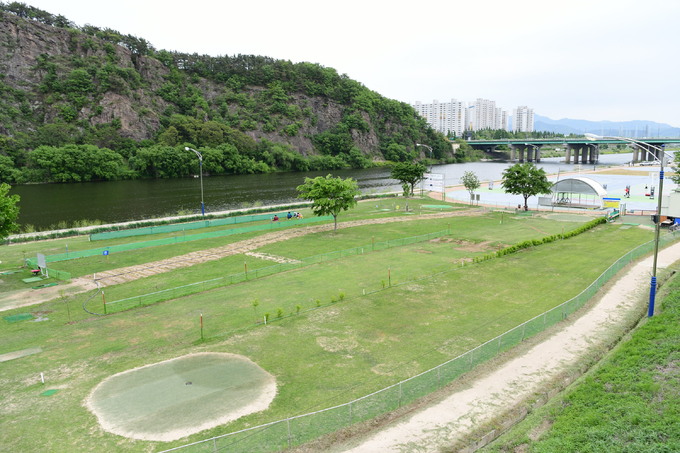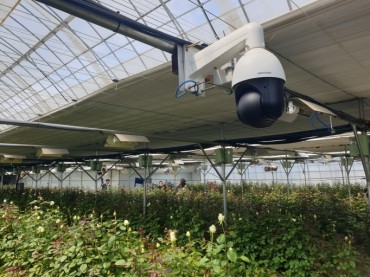
A park golf course near the Namdae Stream in Yangyang County, Gangwon Province, is seen in this photo provided by the county office.
SEOUL, June 27 (Korea Bizwire) — A majority of the park golf courses built along waterways such as the Nakdong River and the Han River have been found to be illegal.
Park golf is gaining popularity as a sport among the aging population, but it is also becoming a social problem due to its negative environmental impact.
The proliferation of park golf courses is causing significant harm to the environment, including the destruction of wildlife habitats and water pollution.
According to data released by the Ministry of Environment on Monday, there were a total of 88 park golf courses along major waterways, of which 56 (64 percent) were deemed to be illegal.
Among the illegal park golf courses, 40 did not possess a river use permit from environmental authorities, while the remaining 16 were expanded without proper authorization.
The ministry plans to order the illegally expanded park golf courses to restore the original sites, and the unauthorized ones to apply for permits.
Park golf, a combination of “park” and “golf” originating in Japan, is an affordable form of mini-golf that can be played in small spaces.
It requires only a club and a plastic ball, and its larger ball size and hole cups make it easier to play than regular golf.
The sport is enjoyed by people of all ages due to its low physical exertion, and the cost for players is either free or very low, making it increasingly popular among middle-aged and elderly individuals.

In this file photo provided by the Gyeongju City Government, seniors are seen playing golf at a park golf course.
Park golf was first introduced in Hokkaido, Japan, in 1983, and the first course in South Korea was established in 1998 at a senior welfare center in Jinju, South Gyeongsan Province.
As of April, there were 361 park golf courses nationwide, totaling 6,619 holes, according to the Korea Park Golf Association.
The number of association members, individuals who belong to a club and enjoy park golf, reached 106,505 last year. This represents a 1.5-fold increase from 2021 (64,001) and over six times more than in 2017 (16,728).
Due to the growing popularity of park golf among middle-aged and elderly individuals, local governments are actively opening new courses or expanding existing ones.
The development of river banks during the restoration project of the four rivers under the Lee Myung-bak administration is believed to have contributed to the increase in new park golf courses.
By utilizing the improved river banks, local governments can quickly and cost-effectively build park golf courses.
However, the excessive construction of park golf courses along river banks and urban green spaces has faced criticism for causing environmental pollution.
The use of pesticides to maintain the turf, destruction of wildlife habitats, contamination of water sources near these courses, and the potential for flooding are among the concerns.
Park golf courses have defended themselves by emphasizing their small footprint.
A park golf course typically consists of a minimum of nine holes, requiring an average area of approximately 10,000 square meters (about 3,000 square feet).
However, in recent years, golf courses have been growing larger due to demand exceeding the existing capacity.
Namhae County plans to host a 72-hole course by 2026, Gungwi County, in North Gyeongsang Province, plans for 180 holes, and Changwon, in South Gyeongsang Province, aims to build a total of 500 holes, the largest among local governments nationwide.
Nevertheless, many proposed park golf course locations are known to be ecologically valuable areas that house legally protected species such as otters, birds of prey, and white-tailed eagles.
Consequently, environmental organizations are strongly opposing their development.
For instance, an environmental organization set up cameras to observe a proposed development site along the Kumho River and discovered numerous signs of endangered wildlife.
This location is the proposed Sasu Park Golf Course in Buk District, Daegu, which is renowned as the mecca of park golf in South Korea.
In recent sightings along the banks of the Geumho River, class 1 endangered wildlife species such as otters and class 2 deer have been observed.
Daegu has the highest number of park golf courses in a single city, currently operating 25 park golf courses (513 holes).
However, as part of the ‘Geumho River Renaissance’ project, the city of Daegu has announced plans to build and expand six new park golf courses (108 holes) along a 41.6-kilometer stretch of the river in the city by 2024.
This will increase the number of park golf courses in the Geumho River basin from 14 to 20, equating to one park golf course every two kilometers.
South Chungcheon Province is one of the representative local governments actively expanding park golf courses.
The province plans to construct 30 new park golf courses by 2024, including a 108-hole park golf course, the largest in South Korea, in Cheongyang Country.
The head of the county recently cited the attraction of a 108-hole park golf course as his second accomplishment in office during local elections.
Jeju Island, which already boasts three park golf courses, has announced plans to invest 8 billion won (US$6.15 million) in building four new courses and doubling the size of the existing ones.
According to the Environmental Impact Assessment Information System, from 2020 to the present, there have been 54 park golf course construction projects that required small-scale environmental impact assessment consultations with environmental authorities.

This photo provided by Hwacheon County Office shows a park golf course in the Gangwon Province county.
Given South Korea’s relatively small land area, the increasing number of recreational facilities in green areas implies a gradual disappearance of wildlife habitats.
Wild animals rely on migrating between mountains and rivers, but the construction of roads has disrupted their migration routes.
Consequently, they lose their habitats and are forced to reside exclusively along rivers. Rivers serve as their last refuge.
However, the uncontrolled development of river banks can be seen as prioritizing human enjoyment while disregarding coexistence with nature and other living beings.
As the number of park golf courses continues to rise, conflicts among residents are also increasing.
This year, Seodaemun District in Seoul invested 750 million won to convert Baeryeon Neighborhood Park into a park golf course.
However, due to strong opposition from residents, the project was halted.
Residents argued that converting a public park into a golf course exclusively for club members was unreasonable, and they also expressed concerns about noise and parking difficulties.
An official from the environment ministry stated that in promoting the creation of park golf courses in river areas, the government aims to minimize environmental damage through environmental impact assessments while primarily utilizing freshwater spaces.
Many citizens are frustrated by the closure of park golf courses due to environmental concerns. Consequently, there is an urgent need for legal regulations that support this hobby while minimizing environmental damage.
Currently, there are no regulations governing the establishment of park golf courses.
The issue is further complicated by the fact that park golf courses have been built throughout the country due to the discretionary judgments of local governments exploiting legal loopholes.
Jerry M. Kim (jerry_kim@koreabizwire.com)







